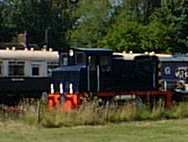|

|
Site contents © Richard Foxcroft 1996-2000
|

|
Site contents © Richard Foxcroft 1996-2000
This line from Coalport, after crossing the site of modern Hollinswood Estate, approached Oakengates along the line of the Queensway. It then dropped into Oakengates, passing under a bridge under Canongate. (Since this photograph they have built houses, and half-buried it. It stood for years, a proud memento on the edge of waste ground; whilst the arch has been long filled, and the other side blocked). Then parallel to Queensway to a station at Oakengates just below the site of the Police Station at the foot of Station Hill. There was an engine house here, now a tile warehouse.
I have received a lot of help with the next stretch from Pat Norbury, since the ground for the rest of the line has been so disturbed as to make any chance of finding actual traces, hopeless. Continuing along the line of the Queensway, it crossed Stafford Road close to where Queensway is now under a bridge. Frome Withington Close it started a descent more-or-less parallel to Queensway, more-or-less along a modern path as far as Wombridge on an embankment. The hedge between the path and the cemetary is old, and almost certainly marks the boundary of the railway at that point.
Then the line; curved left. Chris Williams told me that Middle Pool was once two pools, Middle and Valley; and it passed between them on a high, steep-sided embankment; crossed the site of Blockley's brickworks, emerging just to the left of the big roof in the distance; and crossed Castle St, Hadley, into the GKN Sankey compound, swinging left again to join the Newport - Wellington Line at Hadley Castle.
The point where the line crosses Castle Street is by no means obvious from the road, but you can follow the line back from Castle Lane, not along the footpath (formerly a driveway and leading to a gate on Castle Street) but up the bank to one side, where there are sleepers amongst the baby birch trees. This brings you to Castle Street at the end of a modern brick wall surmounted by an iron railing, almost opposite an unmetalled lane, next to which the embankment can be discerned continuing South. Since writing this, new housing has been built on the former GKN Sankey Sports Ground; how much of what I saw, remains, I do not know.
Jerel Whittingham, an ex-pat now living in Cambridge, sent me his recollections of this line from when he was a boy in the '60s:
I remember the railway line between Oakengates and Hadley very well. It was a big part of my childhood. I am just old enough (born 62) to remember steam trains running on it. I remember playing with my brother and some cousins on the "Gorse banks" " down the fields" behind Withington Close, which abutted the railway line, we ran up to the top of the embankment just as a tank loco whizzed past . I don't think were in much danger but it was quite a shock! I specifically remember the last rain to run on the line before it was closed. We watched out for it from the house in Withington Close (my mum still lives there) and saw the steam coming, then rushed to the other side of the house to see it disappear.
After the line closed I played on the track bed a lot, and used it as the "royal road" down to the Valley Banks (now alas developed but then a wonderful area of steep banks and little "Valleys" and the Middle, Valley and Trench pools). You are right that the railway passed between Valley and Middle: the bit of an Island in the Middle Pool is a remnant of the embankment - see Oakengates.Com (external). I recall the smell and crunch of the black gravel on the old track bed very well and there was loads of wildlife along it. For a while you could still cross the bridge over the path between Withington Close and Wombridge Church, near where the road bridge is now, but eventually more and more holes appeared and I think the bridge was removed. It was great for echoes when walking underneath with my Gran.
There aren't many sign of it left now but I can still see one or 2 since I know here to look!
Top of page
Next page
Contents page